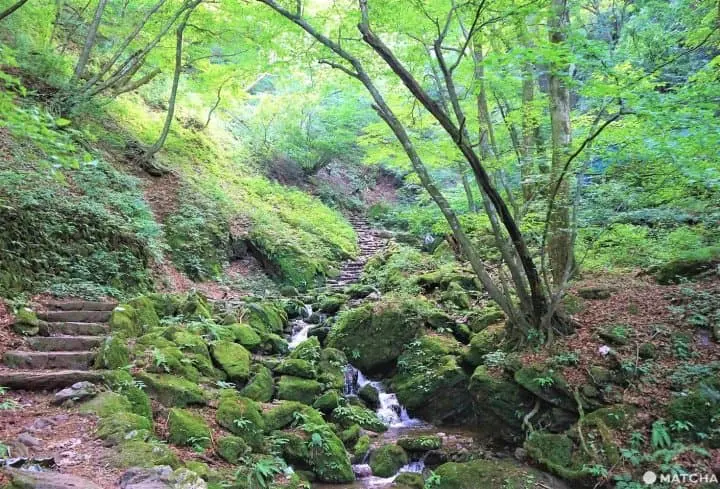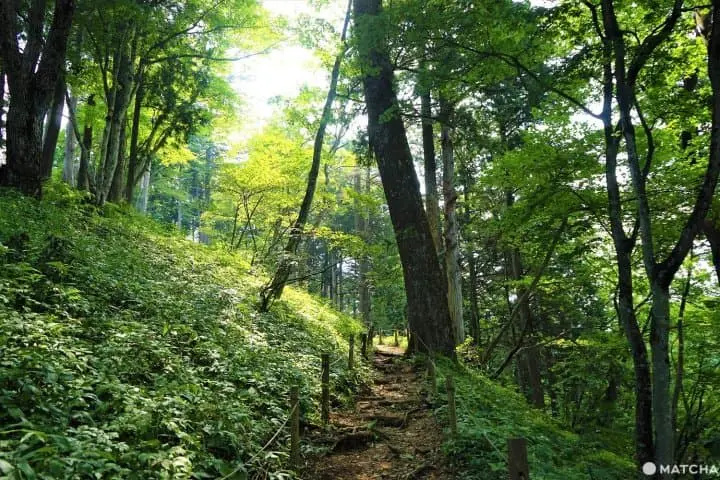The Rock Garden On Mt. Mitake - Listen To A Mountain Stream In Tokyo

If you're looking for an area in Tokyo with no trace of humans, I suggest taking a light hike on Mt. Mitake to reach the Rock Garden. The clear mountain stream, the stunning rock formations, and the moss-covered trees create a breathtaking scenery that seems to exist outside of time.
Tokyo Without People

When we were asked to think about what "Tokyo without people" means to each of us, I immediately thought of the Rock Garden on Mt. Mitake. Whenever I go there, I can't help wondering whether I'm still in Tokyo or maybe I slipped unawares through a wormhole and landed on an uninhabited planet.
The Rock Garden is a place where you can hear the sound of a mountain stream and birds chirping. You wouldn't expect to find a tranquil, wild forest like this in a metropolis like Tokyo.
Mt. Mitake - A Sacred Mountain in Western Tokyo

Mt. Mitake (929 m) is a popular hiking destination in the Chichibu Tama Kai National Park. Travel by the JR Chuo Line for about 90 minutes west from Shinjuku Station and get off at Mitake Station. A local bus takes you from here to the Takimoto cable car station. After a five-minute ride by cable car, you'll be on top of Mt. Mitake.

Mt. Mitake was regarded as a sacred mountain in the past. Practicers of shugendo, an ancient religion that mixes Shinto and Buddhist beliefs, would come to this mountain to practice their austerities.
Musashi Mitake Shrine, located on the summit, flourished as a center for shugendo ascetic practices on Mt. Mitake.

The pathway leading to the shrine is lined with souvenir shops and dining places. They cater to shrine visitors and hikers offering local produce and homemade dishes.

During shrine festivals or seasonal events, this area is visited by many people from the city as Mt. Mitake is a popular day trip and hiking destination.
Otherwise, these quaint streets are very quiet. If you're still around at sunset, you might be surprised at the surrreal silence of this mountain village where time seems to have stopped.
The Beautiful Rock Garden

One of the most beautiful areas on Mt. Mitake is the 1.5 km hiking trail called Rock Garden, which stretches along Yozawa River about one hour away from the shrine. The clear mountain stream, the surrounding forest, and the stunning, moss-covered rock formations make this a place of true beauty.

Ayahironotaki Falls
Ayahironotaki is one of the waterfalls in the Rock Garden. Waterfalls are regarded as sacred in many areas of Japan. And it's no wonder why. The majestic beauty of these natural formations inspires awe. You'll even see Shinto torii gates and shide paper streamers (*1) marking the entrance to a waterfall as sacred ground inhabited by a deity.
*1 Shide... Zigzag-shaped paper streamer used in Shinto rituals.

You might spot groups of children on their school trip playing by the waterfall and trying their hand at waterfall training.

The hiking trail will take you by the mountain side...

... and along the river. Before you even notice, there's no one around you anymore.

The only sound you hear is the murmuring of the mountain stream making its way through the rocks - flowing vigurously from the heart of the mountain toward the ocean.

This part of the forest is protected and kept untouched. From stunning rock formations such as Tengu no Iwa ("Tengu Rock," *2) to moss-covered rocks and trees, the scenery is breathtaking.
*2 Tengu... A mythical creature that's half man, half crow. It is regarded as the protector of shugendo ascetics.

On the way back to the shrine, you'll pass by this strangely shaped cedar. Called Tengu no koshikake sugi ("The Tengu's Cedar Chair"), it is regarded as a sacred tree inhabited by a deity.
Every corner of the Rock Garden will make you reappreciate the majestic beauty of nature. You might also remember that it was this kind of natural scenery that inspired religious feelings in humans in the first place, making them wonder and inquire.
Beautiful Every Season

The hiking trails on Mt. Mitake are open from April to early December, the time of the first snowfall. Visit in the spring and you'll be welcomed by greenery and cherry blossoms at the shrine. In summer, temperatures on the summit are a little lower than in the city, so it's great to visit and forget about the heat for a while. In fall, the forest changes color to vibrant reds and yellows.


Wondering what this beautiful flower is? It's a flower native to Japan called Rengeshoma (Anemonopsis macrophylla, sometimes called "false anemone"). It grows on Mt. Mitake and other humid mountain forests on the Pacific side of Honshu Island. Nicknamed "fairy of the forest," the Rengeshoma flowers bloom in August in the cool, well-shaded mountain forests.
The Mitake Rengeshoma Festival is held every year in August, inviting casual visitors, nature-lovers, and photography enthusiasts to marvel at this little marvel of nature.
Even during festival times, when the area around Mitakesan Station gets animated with visitors, only a few hikers go all the way to the Rock Garden. In other words, no worries about the tranquility of the area being spoiled.
A Quiet Forest in Tokyo

The Rock Garden is a place where you'll encounter an unexpected side of Tokyo - one that is very calm, located in the heart of nature where human presence stops being self-understood. Spend a few hours here, and you'll get to love this city even more.
Ramona, English content editor at MATCHA since 2016, has been practicing ikebana flower arrangement (Ikenobo School) and tea ceremony (Omote Senke) since 2012. She arrived in Japan in 2012 as a graduate student with a focus on Japanese literature and performing arts. As a travel editor and writer, Ramona has visited and documented 40 of Japan's prefectures with a focus on art, history, traditional Japanese crafts, and performing arts.











































![[Coupon Available] Attention Overseas Winter Sports Fans! Nagano's Sports Depot Has Evolved](https://resources.matcha-jp.com/resize/720x2000/2026/01/05-254819.webp)
![[2 hours from Tokyo ] 10 Quiet and Breathtaking Views of Mount Fuji in Yamanashi Hokuto City , Yamanashi - Part 2](https://resources.matcha-jp.com/resize/720x2000/2025/12/16-253037.webp)

![[Reopening in March 2026] Ikoma Sanjo Amusement Park Park, 45 minutes from Osaka , with free admission](https://resources.matcha-jp.com/resize/720x2000/2024/08/28-194409.webp)